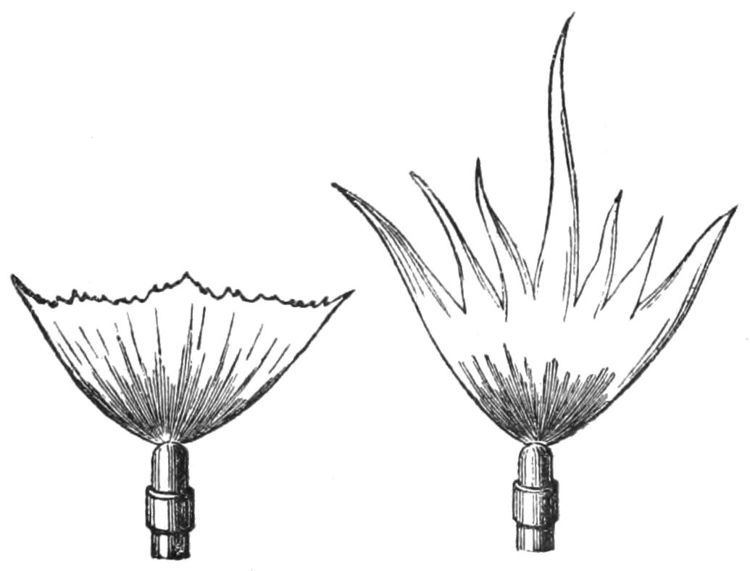 | ||
A sensitive flame is a gas flame which under suitable adjustment of pressure resonates readily with sounds or air vibrations in the vicinity. Noticed by both the American scientist John LeConte and the English physicist William Fletcher Barrett, they recorded the effect that a shrill note had upon a gas flame issuing from a tapering jet. The phenomenon caught the attention of the Irish physicist John Tyndall who gave a lecture on the process to the Royal Institution in January 1867.
In 1857 Prof. John LeConte discovered that an ordinary naked gas-flame, from a fish-tail or bat-wing burner, becomes an indicator of sound by vibrating in unison with an external source, provided the pressure be such that the flame is just ready to flare. This can be easily shown by blowing a shrill whistle or bowing a tuning-fork of high pitch in the immediate neighborhood of the flame, which at once becomes forked (Fig. 3) into several long, vibrating tongues. The effect soon ceases if the pressure be gradually diminished. This result is due to the disturbance produced by sound-waves on the outflowing jet of gas at the nozzle. The high temperature of flame is therefore not necessary for the production of such co-vibration, but serves to make it more easily manifest. Nine years elapsed after Dr. Le Conte's discovery before the subject was taken up again and independently by Mr. W. F. Barrett, in London, who used small cylindrical jets, which were found to flare under similar conditions, and could be rendered far more sensitive. A "pin-hole lava-tip" may be fitted into the end of a metal tube and connected by means of India-rubber tubing to a cylinder of compressed illuminating gas. In connection with this, also, there should be a water manometer gauge for regulating the pressure of the outflowing gas. If the pin-hole is very smoothly cylindrical, the flame mounts up to the height of nearly eighteen inches (Fig. 4, x), with an apparent thickness scarcely more than that of the little finger, and burning quietly. When the pressure approaches ten inches, as indicated by the water-gauge, the flame flares, becoming much shorter and broader, like a little Indian club (Fig. 4, y), and producing a low roaring sound, due to the escape of unburned gas. Let the pressure now be diminished until this flaring barely ceases. The flame is now in its most sensitive condition. Sounds of low or even medium pitch have no effect upon it; but on blowing a shrill whistle, or rattling a bunch of keys anywhere within thirty or forty feet, it flares. Perhaps the most beautiful illustration of its sensitiveness is given by placing an open watch near the nozzle but not touching it; every tick causes a momentary sinking and spreading of the flame, so that the effect may be seen across an audience-room. If the audience applauds with clapping of hands, the flame shrinks in acknowledgment.
